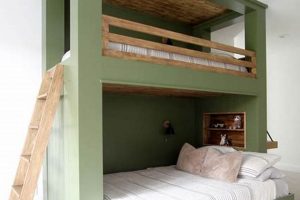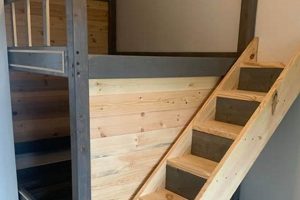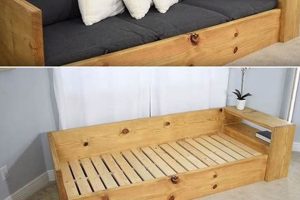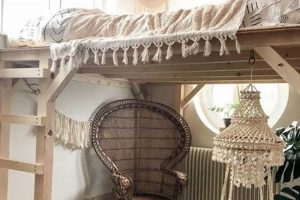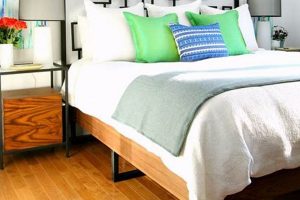The construction of storage units designed for placement beneath a bed, created by individuals using readily available materials and tools, offers a practical solution for maximizing space utilization. These units, often referred to as self-assembled under-bed storage, provide supplemental storage without occupying additional floor area. An example includes building wooden boxes on casters that slide under the bed frame to house clothing or linens.
This approach to storage creation presents several benefits, including cost-effectiveness and customization. Individuals can tailor dimensions and materials to precisely fit their needs and aesthetic preferences. Historically, resourcefulness in space management has driven innovation in furniture design, reflecting a persistent need to optimize living environments, particularly in smaller dwellings.
The subsequent sections will delve into material selection, construction techniques, design considerations, and safety measures applicable to the fabrication of personalized under-bed storage solutions.
Essential Considerations for Under Bed Drawers DIY Projects
The following tips provide guidance for achieving optimal results when undertaking the construction of under-bed storage drawers. Adherence to these recommendations will enhance both the functionality and aesthetic integration of the finished product within the designated space.
Tip 1: Precise Measurement is Critical. Accurately measure the available clearance beneath the bed frame. Account for any obstructions, such as bed frame supports or flooring irregularities. Erroneous measurements can result in drawers that do not fit properly, rendering them unusable.
Tip 2: Material Selection Impacts Longevity. Opt for durable materials such as solid wood or high-quality plywood. Avoid particleboard, which is prone to damage from moisture and weight. Consider the aesthetic compatibility of the chosen material with existing bedroom furniture.
Tip 3: Implement Robust Construction Techniques. Utilize strong joinery methods, such as dovetail joints or pocket-hole screws, to ensure structural integrity. Reinforce corners with metal brackets for added stability. Proper assembly techniques are essential for drawers that withstand regular use.
Tip 4: Optimize Drawer Glides for Smooth Operation. Select drawer glides based on the anticipated weight load and desired smoothness of operation. Ball-bearing slides are generally preferable to friction-based slides. Install glides precisely to prevent binding or misalignment.
Tip 5: Incorporate Adequate Ventilation. Design the drawers with ventilation in mind, especially if storing clothing or linens. Drill small holes in the drawer bottom or back panel to promote airflow and prevent moisture buildup. This reduces the risk of mildew or unpleasant odors.
Tip 6: Consider Handle Placement for Ease of Access. Choose drawer pulls or handles that are comfortable to grip and appropriately sized for the drawer dimensions. Position handles strategically to facilitate easy opening and closing, particularly for drawers located in hard-to-reach areas.
Tip 7: Apply a Protective Finish. Treat the finished drawers with a sealant, stain, or paint to protect the wood from moisture and wear. Ensure the chosen finish is non-toxic and compatible with the intended use. A durable finish will extend the lifespan of the drawers and maintain their aesthetic appeal.
These considerations collectively contribute to the creation of functional and aesthetically pleasing under-bed storage units. Diligent planning and execution are essential for a successful outcome.
The following section will explore common challenges encountered during the construction process and provide corresponding solutions.
1. Accurate Measurement
Accurate measurement serves as the foundational element for successful construction of under-bed storage units. Precise dimensions are paramount to ensure the finished drawers fit appropriately within the designated space beneath the bed frame, allowing for unimpeded operation and maximizing storage capacity.
- Clearance Considerations
The height of the available space dictates the maximum vertical dimension of the drawers. Failure to accurately measure this clearance can result in drawers that cannot be inserted or removed without obstruction. Existing bed frames, bed skirts, and flooring variations must be accounted for.
- Width and Depth Constraints
The overall width and depth of the drawer units are contingent upon the distance between the bed frame legs or side rails. Inaccurate measurements can lead to wasted space or drawers that protrude beyond the bed frame, creating potential tripping hazards. Consider accessibility and maneuverability around the bed when determining maximum drawer dimensions.
- Material Thickness Adjustments
Precise measurements must incorporate the thickness of the construction materials. For instance, if using -inch plywood, this dimension must be factored into the overall drawer dimensions to ensure a snug but functional fit. Neglecting material thickness can result in drawers that are too large or too small for the intended space.
- Glide Mechanism Integration
The type and dimensions of the drawer glides selected influence the necessary clearance within the drawer opening. Ball-bearing glides, for example, require specific side clearances for smooth operation. Inaccurate measurements relating to glide integration can cause drawers to bind or fail to operate correctly.
These facets illustrate the critical role of accurate measurement in achieving a successful under-bed storage solution. Errors in any of these dimensions can compromise functionality, aesthetics, and safety. Rigorous attention to detail during the measurement phase is essential for a satisfactory outcome.
2. Material Durability
Material durability is a critical determinant of the long-term utility and value of self-constructed under-bed drawers. The selection of appropriate materials directly impacts the drawers’ ability to withstand the rigors of repeated use, weight-bearing requirements, and potential environmental stressors within the under-bed environment. For example, utilizing low-density fiberboard increases the likelihood of structural failure, particularly when subjected to heavy loads or moisture exposure, shortening the lifespan of the storage solution. Conversely, employing solid hardwoods or high-grade plywood significantly enhances resistance to warping, cracking, and general wear, thereby extending the operational lifespan of the under-bed drawers.
The inherent characteristics of various materials necessitate careful consideration during the planning phase. Solid wood, while offering superior strength and aesthetic appeal, may be more susceptible to dimensional changes due to fluctuations in humidity. Plywood, an engineered wood product, provides a more stable alternative with consistent strength properties across its surface. The choice depends on the specific environmental conditions within the bedroom and the intended load-bearing capacity of the drawers. Selecting materials resistant to common household pests, such as termites or dust mites, also contributes to the longevity and hygiene of the storage system. Implementing finishes, such as sealants or varnishes, further protects the chosen material from moisture, scratches, and stains, increasing durability.
In summary, material durability constitutes a fundamental aspect of successful under-bed drawer construction. The judicious selection of robust and resilient materials ensures structural integrity, enhances the storage solution’s lifespan, and safeguards the contents stored within. Neglecting this aspect may result in premature failure, necessitating costly repairs or replacements, underscoring the importance of prioritizing material durability from the outset of the project.
3. Joinery Strength
Joinery strength represents a critical element in the design and construction of under-bed drawers. The method by which individual components are connected directly influences the structural integrity and longevity of the finished storage unit, determining its capacity to withstand weight, resist racking forces, and endure the stresses of regular use.
- Load-Bearing Capacity and Joint Type
The type of joint employed must be commensurate with the anticipated load. For example, a basic butt joint, secured only with fasteners, is insufficient for supporting heavy items. Stronger joint configurations, such as dovetail joints, mortise-and-tenon joints, or rabbet joints, provide significantly increased surface area for adhesive bonding and mechanical interlocking, enhancing load-bearing capabilities. Drawers intended for storing dense objects, such as books or tools, necessitate robust joinery to prevent joint failure and structural collapse.
- Resistance to Racking Forces
Racking refers to the distortion of a rectangular structure, where the corners are no longer square. Under-bed drawers, frequently subjected to lateral forces during opening and closing, require joints resistant to racking. Joints reinforced with screws or dowels offer greater resistance to racking compared to those relying solely on adhesive. Corner bracing or the incorporation of a solid back panel further enhances structural stability and mitigates the risk of racking deformation.
- Durability and Long-Term Stability
The chosen joinery method should ensure long-term stability and resistance to degradation. Joints created with waterproof adhesives and corrosion-resistant fasteners offer greater protection against moisture damage and environmental factors. Techniques that minimize stress concentration and distribute forces evenly across the joint contribute to prolonged structural integrity. Proper joint preparation, including accurate cutting and precise alignment, is essential for maximizing the effectiveness of any joinery method and preventing premature failure.
- Impact of Material Selection on Joinery
The characteristics of the construction material influence the suitability of various joinery techniques. Softer woods may be less amenable to complex joinery methods, such as dovetailing, due to their propensity to split or crush. Hardwoods offer greater versatility in joinery options but may require specialized tools and techniques for accurate execution. The compatibility between the chosen material and the selected joinery method is crucial for achieving a strong and durable connection.
In conclusion, joinery strength constitutes an essential consideration in under-bed drawer design and construction. The implementation of appropriate joinery techniques, carefully selected based on load requirements, material properties, and anticipated usage patterns, is crucial for ensuring the structural integrity, durability, and long-term functionality of the finished storage units. Neglecting this aspect can lead to premature failure, compromising both the stored contents and the overall utility of the under-bed drawer system.
4. Glide Functionality
Glide functionality, referring to the smooth and efficient movement of drawers in and out of their enclosures, is a pivotal consideration in the context of self-assembled under-bed drawers. The ease of access and overall user experience are directly impacted by the quality and proper installation of drawer glides.
- Weight Capacity and Glide Selection
The anticipated weight load within the drawer dictates the type of glide required. Light-duty glides, typically made of plastic, are suitable for drawers containing lightweight items such as clothing. However, for drawers intended to store heavier objects, such as books or tools, heavy-duty ball-bearing glides are necessary. Selecting glides with an insufficient weight capacity can lead to premature failure, rendering the drawer difficult or impossible to operate.
- Glide Type and Movement Quality
Various glide types offer differing levels of smoothness and precision in movement. Friction-based glides, while inexpensive, often exhibit jerky or inconsistent motion. Ball-bearing glides provide a smoother and more controlled movement, reducing friction and noise. Soft-close glides incorporate a mechanism that gently pulls the drawer closed, preventing slamming and minimizing wear on the drawer components. The choice of glide type influences both the user experience and the longevity of the drawer system.
- Installation Accuracy and Operational Efficiency
Precise installation of drawer glides is critical for optimal performance. Misaligned or improperly mounted glides can cause binding, sticking, or uneven movement. Accurate measurements and the use of appropriate fasteners are essential for ensuring that the glides are securely and squarely attached to both the drawer and the drawer enclosure. Careful attention to installation details translates directly into smooth, reliable drawer operation.
- Full Extension vs. Partial Extension Glides
The choice between full extension and partial extension glides affects the accessibility of items stored within the drawer. Full extension glides allow the drawer to be pulled completely out of the enclosure, providing unobstructed access to all contents. Partial extension glides only allow the drawer to be partially extended, potentially limiting access to items stored at the back of the drawer. The selection of glide type depends on the intended use of the drawer and the desired level of accessibility.
Collectively, these facets underscore the significance of glide functionality in self-constructed under-bed drawers. Thoughtful selection, precise installation, and appropriate maintenance of drawer glides are vital for ensuring smooth operation, maximizing accessibility, and prolonging the lifespan of the storage system. Compromising on glide functionality can result in a frustrating and ultimately unsatisfactory user experience.
5. Ventilation provision
Adequate ventilation is a crucial, yet often overlooked, aspect of self-assembled under-bed drawers. The confined space beneath a bed, typically characterized by limited airflow and potential temperature fluctuations, creates an environment conducive to moisture accumulation and the proliferation of mold and mildew. Consequently, the absence of proper ventilation within the storage drawers can result in damage to stored items, the development of unpleasant odors, and potentially adverse health effects for occupants of the room. For example, storing clothing or linens within unventilated drawers can lead to mustiness and the growth of mold spores, rendering the items unusable and requiring costly cleaning or replacement. Properly designed ventilation mitigates these risks.
Effective ventilation in under-bed drawers can be achieved through several methods. Incorporating ventilation holes or screened panels into the drawer construction promotes airflow, allowing moisture to evaporate and preventing the buildup of stagnant air. The size and placement of these openings should be carefully considered to balance ventilation with dust intrusion. The selection of breathable materials, such as unfinished wood or natural fabrics for drawer liners, further enhances airflow. Furthermore, regularly airing out the drawers by occasionally removing them from under the bed and exposing them to fresh air can significantly reduce moisture levels. Implementing these measures helps maintain a dry and hygienic storage environment.
In summary, ventilation provision constitutes an essential component of successful under-bed drawer construction. Neglecting ventilation can lead to detrimental consequences for both stored items and the indoor environment. By incorporating ventilation features, selecting breathable materials, and implementing regular airing practices, one can create a safe and hygienic storage solution that protects belongings and promotes a healthy living space. The benefits of adequate ventilation far outweigh the minimal effort required during the design and construction phases.
6. Handle placement
Handle placement significantly impacts the functionality and usability of self-constructed under-bed drawers. Ineffective handle positioning can render even well-built drawers difficult to access and operate, diminishing the overall utility of the storage solution. The height and reach required to grasp the handle are directly influenced by its location, creating a tangible cause-and-effect relationship between placement and ease of use. The ergonomic considerations inherent in accessing under-bed storage necessitate careful attention to handle positioning. For instance, a handle positioned too low may require excessive bending, while one placed too high may be out of reach for some users.
Strategic handle placement is not merely an aesthetic choice but an integral component of an effective under-bed drawer design. The size and weight of the drawers, coupled with the available space under the bed, dictate the optimal handle location. Drawers designed for frequent use benefit from handles positioned for comfortable grip and leverage. Consider the scenario of storing heavy items: centrally located handles, adequately sized for a secure grip, provide balanced leverage for easier pulling. Conversely, small, poorly positioned handles on heavily laden drawers can result in strain and discomfort, ultimately discouraging their regular use.
In summary, the practical significance of understanding handle placement in the context of self-assembled under-bed drawers cannot be overstated. Optimal handle positioning maximizes accessibility, enhances user comfort, and contributes significantly to the overall functionality and lifespan of the storage solution. Poorly considered handle placement diminishes utility, creates ergonomic challenges, and ultimately undermines the investment in creating the storage solution. Addressing this aspect thoughtfully is essential for a successful and satisfying outcome.
7. Protective Finish
The application of a protective finish to self-constructed under-bed drawers is a critical step extending beyond mere aesthetics. It constitutes a practical measure safeguarding the underlying material from environmental factors and physical wear, thereby directly influencing the longevity and usability of the storage solution.
- Moisture Resistance
Under-bed environments are often subject to humidity fluctuations and potential moisture exposure from spills or condensation. A protective finish, such as varnish or sealant, creates a barrier that prevents moisture penetration into the wood. Untreated wood is prone to warping, swelling, and the development of mold or mildew, compromising structural integrity. A moisture-resistant finish mitigates these risks, preserving the dimensional stability and hygiene of the drawers.
- Scratch and Abrasion Resistance
The frequent sliding and movement of under-bed drawers subjects their surfaces to friction and potential scratching from contact with the floor, bed frame, or stored items. A durable protective finish, such as polyurethane, provides a hard, abrasion-resistant layer that minimizes surface damage. This maintains the aesthetic appearance of the drawers and prevents the degradation of the underlying material over time.
- UV Protection
Even though under-bed drawers are not directly exposed to sunlight, indirect UV radiation can still cause fading and discoloration of the wood surface over time. Finishes containing UV inhibitors, such as certain types of varnish or stain, provide a shield against this effect, preserving the original color and appearance of the drawers. This is particularly important for drawers constructed from light-colored woods or finished with colored stains.
- Ease of Cleaning and Maintenance
A protective finish creates a smooth, non-porous surface that is easier to clean and maintain. Spills and stains can be readily wiped away without penetrating the wood, preventing permanent discoloration or damage. Regular cleaning with a mild detergent and water is sufficient to maintain the appearance and hygiene of the drawers. This reduces the effort required for upkeep and ensures the long-term aesthetic appeal of the storage solution.
These considerations demonstrate that the selection and application of a suitable protective finish are integral to the successful creation of under-bed drawers. Such action not only enhances aesthetic appeal but ensures the durability and hygiene of the storage units. Proper finishing is an investment in the longevity and continued functionality of the self-built storage system.
Frequently Asked Questions
This section addresses common inquiries regarding the construction of under-bed storage drawers, providing clear and concise information to facilitate informed decision-making.
Question 1: What is the optimal material for constructing under-bed drawers intended for long-term storage?
Durable plywood or solid wood are generally recommended. Avoid particleboard due to its susceptibility to moisture damage and structural weakness under sustained loads.
Question 2: How can adequate ventilation be ensured within under-bed storage drawers?
Incorporate ventilation holes or screened panels into the drawer construction. The use of breathable drawer liners, such as natural fabrics, also promotes airflow. Periodic removal of the drawers for airing is beneficial.
Question 3: What type of drawer glides are most suitable for drawers containing heavy items?
Heavy-duty ball-bearing drawer glides are recommended for drawers designed to support substantial weight. These glides offer superior smoothness and durability compared to friction-based or light-duty alternatives.
Question 4: How is accurate measurement ensured when constructing under-bed drawers?
Measure the available space beneath the bed frame with precision, accounting for obstructions such as bed frame supports or flooring irregularities. Incorporate material thickness and glide dimensions into the calculations.
Question 5: What joinery methods are most effective for ensuring the structural integrity of under-bed drawers?
Strong joinery techniques, such as dovetail joints, mortise-and-tenon joints, or pocket-hole screws, are recommended. Reinforce corners with metal brackets for added stability, particularly for drawers intended to support heavy loads.
Question 6: Is a protective finish necessary for under-bed drawers?
A protective finish is highly recommended. It safeguards the wood from moisture, scratches, and UV radiation, prolonging the lifespan and maintaining the aesthetic appeal of the drawers. Select a non-toxic finish suitable for the intended use.
These answers underscore the importance of meticulous planning and execution when undertaking the construction of personalized under-bed storage solutions.
The following section will present troubleshooting tips for common challenges encountered during the assembly of under-bed drawers.
Under Bed Drawers DIY
The preceding exploration of under bed drawers diy encompassed critical considerations for successful implementation. Precise measurement, material selection, joinery techniques, glide functionality, ventilation, handle placement, and protective finishes were identified as essential components for achieving a durable and functional storage solution. Attention to detail in each of these areas contributes significantly to the long-term utility of the project.
The creation of effective under-bed storage represents a practical approach to space optimization within the home. While requiring careful planning and execution, the construction of personalized units provides a cost-effective alternative to commercially available options. Prioritizing sound construction principles and selecting appropriate materials remains crucial for realizing a valuable and lasting addition to the living environment. Future advancements in materials and construction techniques may further enhance the accessibility and durability of such storage solutions.


